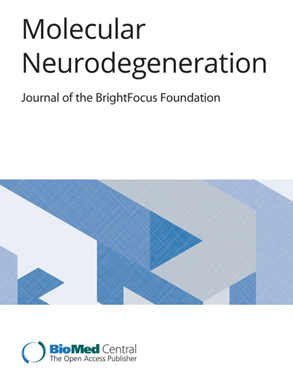Endothelium-specific endoglin triggers astrocyte reactivity via extracellular vesicles in a mouse model of Alzheimer’s disease
IF 17.5
1区 医学
Q1 NEUROSCIENCES
引用次数: 0
Abstract
Alzheimer’s disease (AD) is a multifaceted neurodegenerative disorder with a complex etiology that extends beyond the well-documented amyloid-β and tau pathologies. Growing evidence implicates cerebrovascular dysfunction, particularly brain microvascular endothelial cells (BMECs) dysfunction, as an early contributor to AD pathogenesis. However, how BMECs influence on neighboring astrocytes needs to be further explored. We employed a multi-omics approach integrating bulk RNA sequencing of human BMECs with proteomic analysis of cerebrospinal fluid (CSF) from AD patients and cerebrovascular endothelial extracellular vesicles (CEEVs). The role of identified candidate proteins was investigated in vitro and in vivo utilizing CEEVs transplantation and BMEC-astrocyte co-cultures. Endothelial cell-specific knockdown or treatment with a monoclonal antibody was used to assess the functional consequences on cognitive impairment and AD pathology via two-photon imaging and behavioral experiments on APP/PS1 mice. The elevated endothelium-specific protein Endoglin (ENG) was identified in the brain and serum of AD individuals and APP/PS1 mice, and the supernatant of injured BMECs. ENG was released and delivered to adjacent astrocytes via CEEVs, and subsequently upregulated TGFBRI/Smad3 pathway in astrocytes, leading to astrocyte reactivity and the release of pro-inflammatory cytokines. Endothelial cell-specific ENG knockdown or treating with ENG monoclonal antibody Carotuximab significantly suppressed reactive astrocytes, reduced neuroinflammation, and improved cognitive performance of APP/PS1 mice. This study reveals a novel mechanism by which BMECs-derived ENG, delivered via CEEVs, drives astrocyte reactivity. These findings redefine the role of cerebrovascular dysfunction in AD pathogenesis and identify ENG as both a potential biomarker and a promising therapeutic target for AD.在阿尔茨海默病小鼠模型中,内皮特异性内啡肽通过细胞外囊泡触发星形胶质细胞反应性
阿尔茨海默病(AD)是一种多方面的神经退行性疾病,其病因复杂,超出了充分记录的淀粉样蛋白-β和tau病理。越来越多的证据表明脑血管功能障碍,特别是脑微血管内皮细胞(BMECs)功能障碍,是AD发病的早期因素。然而,bmec对邻近星形胶质细胞的影响还有待进一步探讨。我们采用了一种多组学方法,将人bmec的大量RNA测序与AD患者脑脊液(CSF)和脑血管内皮细胞外囊泡(CEEVs)的蛋白质组学分析结合起来。在体外和体内利用CEEVs移植和bmec -星形胶质细胞共培养研究了鉴定的候选蛋白的作用。应用内皮细胞特异性敲除或单克隆抗体治疗APP/PS1小鼠,通过双光子成像和行为实验评估其对认知障碍和AD病理的功能影响。在AD个体和APP/PS1小鼠的脑和血清以及损伤bmec的上清液中检测到内皮特异性蛋白内啡肽(engin,内皮特异性蛋白)升高。ENG通过ceev释放并传递到邻近的星形胶质细胞,随后上调星形胶质细胞中的TGFBRI/Smad3通路,导致星形胶质细胞的反应性和促炎细胞因子的释放。内皮细胞特异性ENG敲除或用ENG单克隆抗体Carotuximab治疗可显著抑制反应性星形胶质细胞,减少神经炎症,改善APP/PS1小鼠的认知表现。这项研究揭示了一种新的机制,通过ceev传递bmecs衍生的ENG,驱动星形胶质细胞的反应性。这些发现重新定义了脑血管功能障碍在阿尔茨海默病发病机制中的作用,并将ENG确定为阿尔茨海默病的潜在生物标志物和有希望的治疗靶点。
本文章由计算机程序翻译,如有差异,请以英文原文为准。
求助全文
约1分钟内获得全文
求助全文
来源期刊

Molecular Neurodegeneration
医学-神经科学
CiteScore
23.00
自引率
4.60%
发文量
78
审稿时长
6-12 weeks
期刊介绍:
Molecular Neurodegeneration, an open-access, peer-reviewed journal, comprehensively covers neurodegeneration research at the molecular and cellular levels.
Neurodegenerative diseases, such as Alzheimer's, Parkinson's, Huntington's, and prion diseases, fall under its purview. These disorders, often linked to advanced aging and characterized by varying degrees of dementia, pose a significant public health concern with the growing aging population. Recent strides in understanding the molecular and cellular mechanisms of these neurodegenerative disorders offer valuable insights into their pathogenesis.
 求助内容:
求助内容: 应助结果提醒方式:
应助结果提醒方式:


